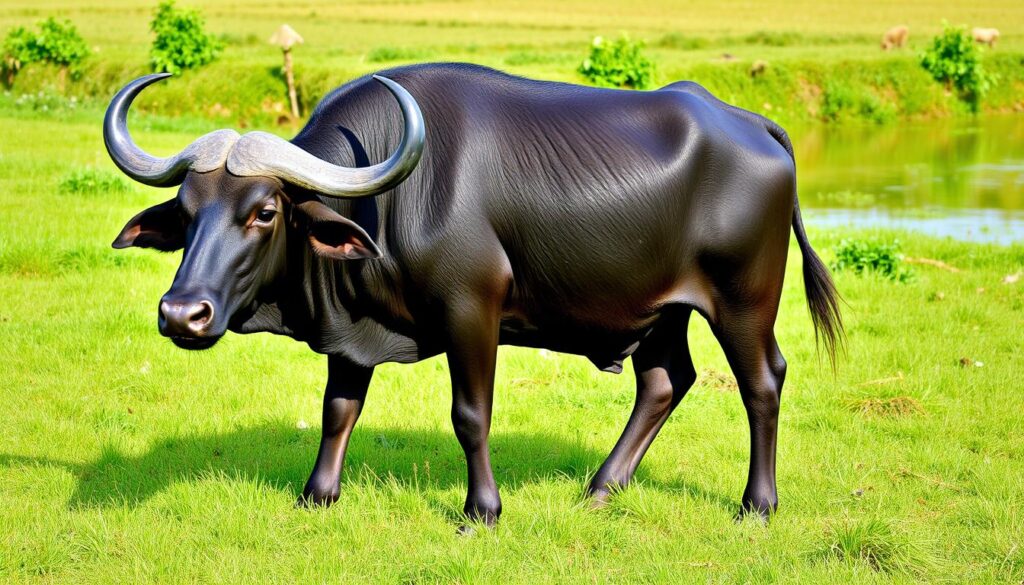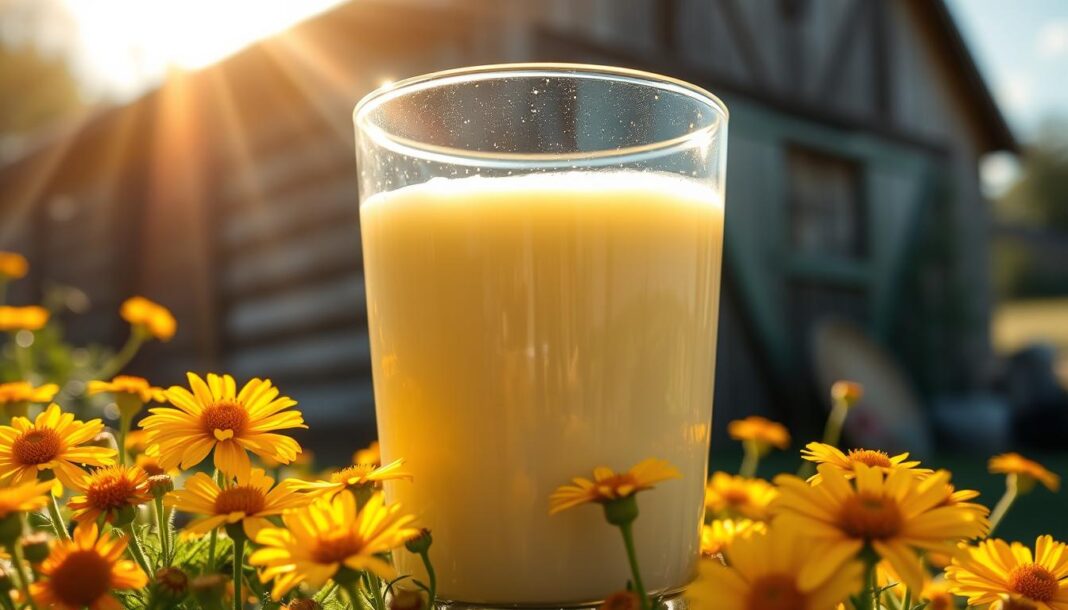Did you know the Nili Ravi buffalo from Pakistan can produce up to 2,600 kilograms of milk per lactation? This breed, also known as the Panch Kalyani, is mainly found between the Sutlej and Ravi rivers in the undivided Punjab Province. The Nili and Ravi breeds were once separate but are now crossbred, making the Nili Ravi buffalo highly valued in the dairy industry.
In the Indian and Pakistani Punjab, the Nili Ravi buffalo is highly sought after. It’s known for its high milk yield and unique physical traits. In this article, we’ll explore what makes the pure Nili Ravi buffalo special. We’ll give you the tools to spot this remarkable bovine breed.
Introduction to the Nili Ravi Buffalo
Origin and Characteristics
The Nili Ravi buffalo comes from the Punjab region of the Indian subcontinent. It is believed to have come from the wild Arni buffalo. These animals are big, have curled horns, and love to swim in clean rivers.
They are very important in Pakistan and India. They are known for producing a lot of milk.
In Pakistan, there are about 32.7 million buffaloes. They make up about 15% of the world’s buffalo population. The Nili-Ravi and Kundi breeds are the most common, making up 38% and 25% of the population.
These indigenous livestock resources are key to Pakistan’s dairy industry. They also help many people who work with water buffalo husbandry.
Nili Ravi buffaloes are big, with males weighing 500-600 kg and females weighing 300-400 kg. They reach maturity at 30 months for males and 36 months for females. This makes them a strong and productive breed.
They are famous for their high milk production. Nili Ravi buffaloes can produce 1,700-2,200 liters of milk per lactation. Their milk has about 6% butterfat. This makes them very important for India’s dairy industry, helping many farming families.
Identifying the Pure Nili Ravi Buffalo
The pure Nili Ravi buffalo is a famous breed from Pakistan. It has unique physical traits that make it stand out. These traits include a striking appearance and several key features.

The Nili Ravi buffalo is known for its white markings, called “Panch Kalyani.” These markings are on the forehead, face, muzzle, legs, and tail switch. The presence of these white markings is the most desirable feature for a pure Nili Ravi buffalo.
This buffalo also has walled eyes, a trait that sets it apart from other Pakistani buffalo breeds. While similar in milk production to the Murrah breed, the Nili Ravi can be easily identified by its unique coloration and markings.
It’s important to carefully observe these physical traits to determine a Nili Ravi buffalo’s purity. By understanding the breed’s distinctive characteristics, enthusiasts and breeders can confidently identify and preserve the authentic Nili Ravi lineage.
| Characteristic | Percentage of Nili Ravi Calves |
|---|---|
| Black Coat Color with White Markings | 95.1% |
| Black and White Facial Markings | 90% |
| Grey Hooves | 81.25% |
| White Tail Switch | 85.5% |
| Blackish Eyelashes | 71.87% |
| Gray Muzzle with Black Pigment | 87.5% |
Coat Color and Markings
The Nili Ravi buffalo is a prized breed from Pakistan. It is known for its unique coat color and striking white markings. These features make the breed visually appealing and important to breeders and enthusiasts.
The Significance of White Markings

The Nili Ravi buffalo often has a deep, dark blue or blue-black coat. But, it can also have shades of brown or pure white. The breed is known for its white markings on the forehead, face, muzzle, legs, and tail.
These white markings, called “Panch Kalyani,” are not just beautiful. They are also seen as signs of the breed’s purity and good production traits. Breeders work hard to keep and improve these markings. They see them as proof of the Nili Ravi’s genetic quality and excellence.
The Nili Ravi buffalo’s coat color and white markings are key to identifying it. These traits have made the Nili Ravi a sought-after breed worldwide. It is valued for its economic importance and dairy industry prospects.
Body Structure and Conformation
The Nili Ravi buffalo is a large, well-built animal. It has a distinctive body structure. They have a wedge-shaped, heavy, and muscular body with a deep barrel.
The head is small, and the legs are short but sturdy. They have strong, black hooves. The horns are tightly curled and distinctive, adding to the breed’s impressive appearance.

These physical characteristics help the Nili Ravi thrive in the hot, humid climate of the Punjab. They are suitable for both dairy and draft purposes. Their robust build and adaptability make them valuable in the Pakistani dairy industry.
| Nili Ravi Male | Kundhi Male |
|---|---|
| Live body weight: 571.52 ± 41.11 kg | Live body weight: 544.44 ± 31.76 kg |
| Carcass weight: 314.4 ± 27.62 kg | Carcass weight: 272.68 ± 21.00 kg |
| Dressing percentage: 54.99 ± 2.45% | Dressing percentage: 50.07 ± 2.22% |
The Nili Ravi buffalo is a distinct breed. It has a robust and well-proportioned body structure. This contributes to its adaptability and economic importance in the Pakistani buffalo industry.
Breeding and Genetic Lineage
The Nili Ravi buffalo breed comes from the wild Arni buffalo of the Indian subcontinent. Keeping the Nili Ravi pure and with its best traits is key. This is done through careful selective breeding.
Maintaining Purity Through Selective Breeding

In Punjab, Pakistan, and India, breeders focus on breeding Nili Ravi buffaloes. They choose animals with white markings and high milk production for breeding. This careful selection has helped keep the Nili Ravi’s unique genetic makeup and milk production abilities for many generations.
Research shows the Nili Ravi breed has fewer alleles than other breeds. The average number of alleles per locus is 2.52. The average heterozygosity value is 0.43, showing moderate genetic diversity.
The polymorphic information content of microsatellite markers is 0.53, indicating moderate genetic variation. The mean Fis value is 0.13, showing deviations from Hardy-Weinberg Equilibrium in most loci. The mean Fst value is 0.07, showing low genetic diversity among the studied buffalo populations.
The average gene flow (Nm) is 3.31, showing the need for selective breeding to keep the Nili Ravi pure. This highlights the breeders’ role in preserving the Nili Ravi buffalo and its genetic lineage.
Pure Nili Ravi Buffalo
The pure Nili Ravi buffalo is famous in the Indian subcontinent. It’s known for its unique looks, great milk, and strong build. To spot a true Nili Ravi, look for its walled eyes, white face and leg markings, and curled horns.
For centuries, breeders in Punjab have worked hard to keep the Nili Ravi pure. They’ve kept the breed’s genetic line strong. This ensures the Nili Ravi’s amazing milk and toughness are passed down.
Now, the pure Nili Ravi buffalo is very valuable. It costs between ₹70,000 to ₹2,55,000. People want it for its milk, which can be up to 16 liters a day, and its ability to thrive in local conditions.
Keeping the Nili Ravi breed pure is key. It means we can keep getting this high-quality milk. Efforts to protect and breed this buffalo are vital for its future.
Milk Production and Economic Importance
The Nili Ravi buffalo is famous for its high milk production. It can produce about 1,850 kilograms of milk per lactation. The milk has a fat content of 6.8%, making it very valuable. This milk is in high demand, boosting the dairy industry in Pakistan and India.
The Nili Ravi buffalo is more than just a source of milk. It is a key genetic resource and a vital income source for many rural communities. In fact, buffaloes produce about 15% of the world’s milk. In developing countries, they are responsible for one-third of the milk, with Asia and Africa leading the way.
The Nili Ravi Buffalo: A Valuable Resource

South Asia is home to 78% of the world’s buffalo population. They produce around 100 million metric tons of milk, making up 93% of global buffalo milk. Buffalo milk is responsible for 51% of milk production in South Asia. Countries like Nepal, Pakistan, and India lead in buffalo milk production.
The chemical makeup of buffalo milk, including that from the nili ravi buffalo, is key for economic policies. It greatly affects the economy of milk production and the financial well-being of farmers. As a pakistani buffalo breed with outstanding dairy qualities, the Nili Ravi buffalo is a precious asset for the dairy industry.
Conservation and Promotion Efforts
The Nili Ravi buffalo is a key part of Pakistani culture. Many groups are working hard to save this breed. They see its value and want to protect it for the future.

In Pakistan, the government has set up special farms for these buffaloes. Places like the Livestock Experiment Station in Bahadurnagar, Okara, focus on keeping the breed pure. They also teach farmers why it’s important to keep the Nili Ravi buffalo alive.
In India, the National Dairy Development Board (NDDB) leads the way in saving the Nili Ravi buffalo. They work to spread the word about its high milk production and ability to thrive in different weather. Their goal is to make the Nili Ravi buffalo a good choice for Indian farmers.
The Brainstorming Session on ‘Breeding Policy for Cattle and Buffalo in India’ was a big event in 2014. It brought together top scientists to talk about how to keep the Nili Ravi and other buffalo breeds safe.
These efforts are key to keeping the Nili Ravi buffalo safe for the future. They aim to keep the breed pure and show its value. This will help the nili ravi buffalo and the Pakistani dairy industry thrive for years to come.
Conclusion
The Nili Ravi buffalo is a special breed from Pakistan’s Punjab region. It’s known for its unique looks, high milk production, and ability to adapt to local conditions. This buffalo has been a key part of the area’s farming and dairy for centuries.
Efforts to save this breed are ongoing. By careful breeding and spreading the word about its value, we can help it thrive. This will benefit the dairy industry and local communities.
The Nili Ravi buffalo is facing challenges like environmental changes and competition. It’s important to show its unique qualities and value. By doing so, we can ensure its survival and keep it as a valuable part of the dairy scene.




